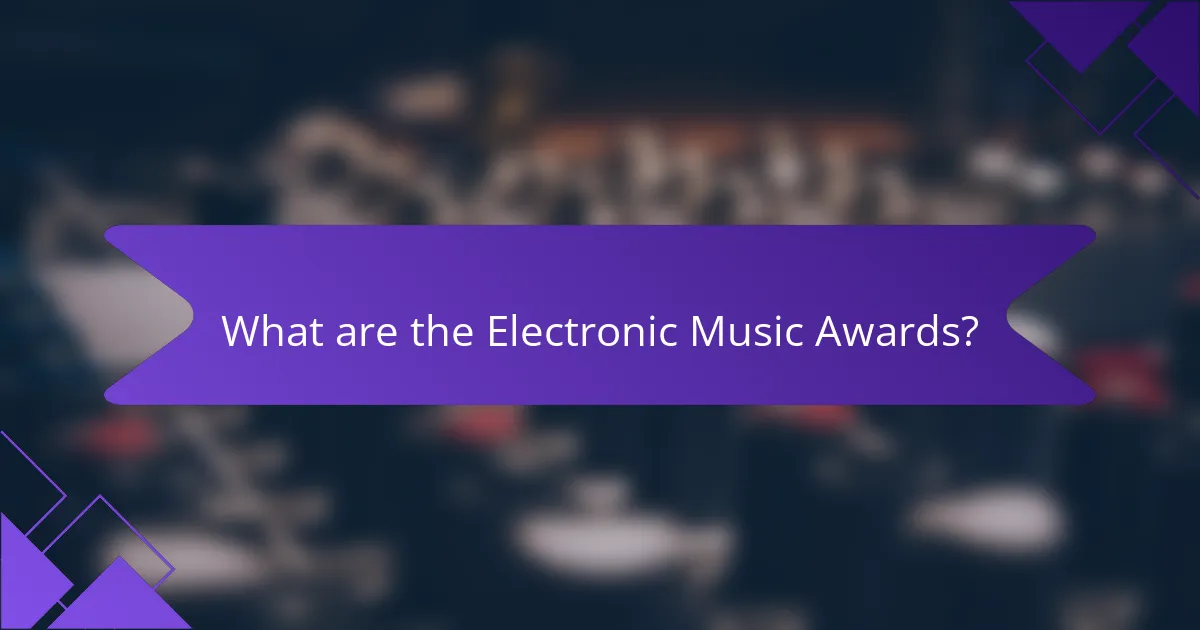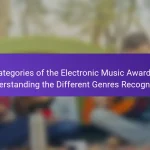The Electronic Music Awards serve as a recognition platform celebrating achievements in electronic music, honoring artists, producers, and industry professionals. Key categories include Best New Artist and Best Album, with the inaugural ceremony held in 2017. The Best New Artist category evaluates debut releases, innovative contributions, and the artist’s growing popularity within the genre. Artists can enhance their chances of winning by building a strong fan base, engaging on social media, and consistently releasing high-quality music. The awards are determined through a combination of public voting and industry expertise, providing a comprehensive view of emerging talent in electronic music.

What are the Electronic Music Awards?
The Electronic Music Awards are a recognition platform for achievements in electronic music. They celebrate artists, producers, and industry professionals within the genre. The awards focus on various categories, including Best New Artist and Best Album. The inaugural ceremony took place in 2017. The event aims to honor innovation and creativity in electronic music. It also provides a space for fans to engage with their favorite artists. The awards are determined by a combination of public voting and industry expertise.
How did the Electronic Music Awards originate?
The Electronic Music Awards originated in 2016. They were created to recognize and celebrate achievements in electronic music. The awards aimed to honor artists, producers, and other contributors in the electronic music genre. The inaugural event took place in Los Angeles. It featured various categories, including Best New Artist. The awards sought to provide a platform for emerging talent in the electronic music scene. The founding team included industry professionals and artists. Their goal was to elevate the profile of electronic music within the broader music industry.
What was the initial purpose of the Electronic Music Awards?
The initial purpose of the Electronic Music Awards was to recognize and celebrate achievements in electronic music. It aimed to provide a platform for artists within the genre. The awards sought to honor both established and emerging talents. This initiative was launched to increase visibility for electronic music. It also aimed to foster community engagement within the electronic music scene. The Electronic Music Awards were created to highlight the diversity of the genre. They intended to promote innovation and creativity among artists. The inaugural event took place in 2016, marking a significant moment for the electronic music industry.
How have the Electronic Music Awards evolved over time?
The Electronic Music Awards have evolved significantly since their inception. Initially launched in 2017, the awards aimed to recognize achievements in electronic music. Over the years, the categories have expanded to include a wider range of genres and artists. The introduction of fan voting has increased audience engagement and participation. Additionally, the awards have adapted to changes in the music industry, reflecting trends and emerging artists. The 2020 ceremony was notably virtual due to the pandemic, showcasing innovation in event formats. Overall, the Electronic Music Awards have grown in scope and relevance within the electronic music community.
What is the significance of the Best New Artist category?
The Best New Artist category recognizes emerging talent in the music industry. This category highlights artists who have gained significant attention in a short period. Winning this award can significantly boost an artist’s visibility and career trajectory. Historically, many winners have gone on to achieve lasting success. The category serves as a platform for new artists to showcase their work. It also reflects the evolving trends within the electronic music genre. Awards in this category can influence industry perceptions and opportunities for nominees. Overall, the Best New Artist category is crucial for promoting fresh talent in the music scene.
Why is the Best New Artist category important for emerging artists?
The Best New Artist category is crucial for emerging artists as it provides significant recognition. This recognition can lead to increased visibility in the music industry. Visibility often results in more opportunities for performances and collaborations. Winning or being nominated can attract attention from record labels. Record labels may offer contracts to promising new talent. Additionally, this category can enhance an artist’s credibility among peers. For instance, many successful artists, like Billie Eilish, gained momentum from such accolades. Consequently, the Best New Artist category serves as a vital launching pad for new careers in music.
What impact does winning the Best New Artist award have on an artist’s career?
Winning the Best New Artist award significantly boosts an artist’s career. This accolade often leads to increased visibility and recognition in the music industry. Artists typically experience a surge in album sales and streaming numbers following the win. For instance, many past winners have reported a notable rise in their social media following after receiving the award. Additionally, winning can attract lucrative opportunities such as sponsorships and collaborations. The award also enhances credibility, making it easier for artists to secure performances at major festivals and events. Overall, the impact of this award can be transformative, propelling artists into mainstream success.

What are the criteria for the Best New Artist category?
The criteria for the Best New Artist category include the artist’s debut release and significant impact in the electronic music scene. Eligible artists must have released their first single or album within the eligibility period. They should demonstrate innovative contributions to the genre. Additionally, there must be evidence of growing popularity and recognition within the music industry. Nominations often consider critical acclaim and audience reception. The artist’s potential for future success is also a key factor in the selection process. These criteria ensure that deserving new talent is recognized at the Electronic Music Awards.
How are nominees for the Best New Artist selected?
Nominees for the Best New Artist are selected through a voting process by industry professionals. This includes musicians, producers, and executives in the electronic music field. The selection criteria focus on the artist’s impact, innovation, and popularity in the past year. Eligible artists must have released music that gained significant attention and acclaim. The process typically involves a review of charts, streaming statistics, and media coverage. This ensures a comprehensive evaluation of each artist’s success and potential. The final nominees are then announced ahead of the awards ceremony.
What factors are considered in the nomination process?
The nomination process for the Electronic Music Awards considers several key factors. These factors include artistic merit, innovation in electronic music, and audience impact. Additionally, the nominee’s contribution to the genre and their overall popularity are evaluated. Industry recognition and critical acclaim also play significant roles in the selection. Furthermore, the eligibility period for releases is strictly defined to ensure fairness. Each of these factors contributes to a comprehensive assessment of potential nominees.
How does public voting influence the selection of nominees?
Public voting significantly influences the selection of nominees by allowing fans to express their preferences. This engagement helps to democratize the nomination process. When the public votes, it reflects the popularity of artists among listeners. The votes can determine which artists receive nominations for categories like Best New Artist. A higher number of votes can elevate an artist’s visibility and credibility. Furthermore, public voting can create a sense of community among fans. It encourages more participation in the awards process. Ultimately, public votes can shape the outcome of nominations in meaningful ways.
What qualifications must an artist meet to be eligible?
Artists must demonstrate originality and innovation in their musical work to be eligible. They should have released at least one original track within the eligibility period. Additionally, artists must have a significant online presence and engagement with their audience. This includes metrics such as streaming numbers and social media following. Furthermore, they should not have been nominated for any major electronic music awards in previous years. These criteria ensure that only emerging talent is recognized. Eligibility is typically assessed by a panel of industry experts.
What defines a “new artist” in the context of the awards?
A “new artist” in the context of the Electronic Music Awards is defined as an individual or group that has recently emerged in the music industry. This typically includes artists who have released their first significant work within the eligibility period for the awards. The eligibility period is often defined as a specific timeframe, such as the past year, during which the artist has gained recognition for their contributions. New artists are usually those who have not previously received major awards or nominations in the same category. This classification helps to highlight and promote fresh talent in the electronic music scene.
Are there any restrictions on the type of music an artist can produce?
Yes, there are restrictions on the type of music an artist can produce. These restrictions often stem from contractual obligations, genre-specific expectations, and copyright laws. For example, record labels may require artists to produce music within specific genres to maintain brand identity. Additionally, copyright laws protect original works, limiting artists from using samples without permission. Artists may also face restrictions based on their target audience or commercial viability. These factors collectively influence the type of music that can be produced.

Who are the past winners of the Best New Artist category?
It is not possible to provide a definitive list of past winners of the Best New Artist category at the Electronic Music Awards. The specific winners can vary by year and are not consistently documented in a single source. Therefore, without a reliable database or record of winners, I cannot accurately answer this question.
What notable artists have won the Best New Artist award?
Notable artists who have won the Best New Artist award include Billie Eilish, Chance the Rapper, and H.E.R. Billie Eilish won the award in 2020. Chance the Rapper received the honor in 2017. H.E.R. was awarded Best New Artist in 2019. These artists have made significant impacts in the music industry shortly after their debut. Each has contributed unique styles and sounds to contemporary music. Their recognition as Best New Artist highlights their talent and potential for future success.
How have past winners impacted the electronic music scene?
Past winners have significantly shaped the electronic music scene by introducing innovative sounds and styles. Artists like Skrillex and Zedd redefined genres, blending electronic music with pop and dubstep elements. Their success has inspired a new generation of producers and DJs. The recognition from awards has elevated their visibility and credibility in the industry. This, in turn, has led to increased collaboration among artists across genres. Moreover, past winners often set trends that influence festival lineups and music production techniques. Their impact is evident in the growing mainstream acceptance of electronic music. As a result, the electronic music scene has expanded its audience and cultural relevance.
What trends can be observed among past winners?
Past winners of the Electronic Music Awards often share specific trends. Many winners have a strong presence on social media platforms. This presence helps them connect with fans and promote their music. Additionally, past winners frequently showcase unique soundscapes that blend various genres. This genre fusion often appeals to a wider audience. Another trend is the collaboration with established artists, which boosts their visibility. Data shows that winners often release multiple tracks before winning. Consistent releases help build their reputation in the industry. Lastly, many winners engage in live performances, enhancing their popularity. These trends highlight the strategies that contribute to success in the electronic music scene.
What can we learn from the history of past winners?
The history of past winners reveals trends and patterns in the electronic music industry. Analyzing previous winners can highlight the evolving sound and style preferences of audiences. It also showcases the impact of marketing and promotion on an artist’s success. Notably, winners often have significant social media followings, indicating the importance of digital presence. Furthermore, past winners frequently collaborate with established artists, which can enhance their visibility. The diversity of genres represented among winners reflects the broadening scope of electronic music. Historical data shows that many winners have received critical acclaim, suggesting a correlation between artistic merit and award recognition. Overall, the history of past winners provides valuable insights into the factors that contribute to success in the electronic music scene.
How does the recognition of past winners reflect changes in the electronic music industry?
Recognition of past winners highlights the evolving trends and styles within the electronic music industry. For instance, early winners often represented specific subgenres, such as trance or house. Over time, winners have increasingly come from diverse genres, reflecting the industry’s expansion. This shift indicates a growing acceptance of fusion styles and cross-genre collaborations. Additionally, the rise of digital platforms has influenced the recognition of artists. Many recent winners gained popularity through online streaming and social media. This change underscores the industry’s adaptation to new distribution methods. Overall, the recognition of past winners serves as a barometer for broader cultural shifts in electronic music.
What common traits do successful past winners share?
Successful past winners of the Electronic Music Awards share traits such as creativity, innovation, and a strong work ethic. They consistently produce unique sounds that stand out in the electronic music genre. Many have a solid understanding of music production techniques and technology. Their ability to engage with audiences through live performances is also notable. Collaboration with other artists often enhances their visibility and reach. Additionally, successful winners frequently utilize social media for promotion. Their commitment to continuous learning and adaptation to industry trends contributes to their success. These traits have been observed in various award-winning artists over the years.

How can artists improve their chances of winning the Best New Artist award?
Artists can improve their chances of winning the Best New Artist award by focusing on building a strong fan base. Engaging actively on social media platforms increases visibility. Releasing high-quality music consistently showcases talent. Collaborating with established artists can enhance credibility. Performing at live events helps gain exposure. Participating in music competitions can attract attention from industry professionals. Lastly, submitting music to relevant award shows ensures consideration. These strategies align with trends observed in previous winners. For example, many successful artists had significant social media followings prior to their nominations.
What strategies should emerging artists consider?
Emerging artists should consider building a strong online presence. This includes creating a professional website and active social media profiles. Engaging with fans through regular updates is crucial. Collaborating with other artists can enhance visibility. Participating in local events and festivals helps in networking. Utilizing music streaming platforms increases exposure. Submitting music to blogs and playlists can attract attention. Consistent branding across all channels strengthens identity.
How can artists build a strong fan base before the awards?
Artists can build a strong fan base before the awards by actively engaging with their audience on social media platforms. Regularly posting updates, behind-the-scenes content, and personal stories helps to create a connection. Collaborating with other artists can also expand their reach to new audiences. Hosting live performances or virtual events allows artists to showcase their talent and interact with fans directly. Offering exclusive content or merchandise can incentivize fans to support them. Consistent branding and messaging across platforms reinforce their identity. Lastly, participating in music festivals or local events increases visibility and helps to attract new fans. These strategies are proven effective as many successful artists have utilized them to grow their fan base before major awards.
What role does social media play in an artist’s visibility?
Social media significantly enhances an artist’s visibility. It allows artists to reach a broader audience quickly. Platforms like Instagram, Twitter, and TikTok enable direct interaction with fans. This engagement fosters community and loyalty. According to a 2021 survey by Statista, 54% of musicians use social media for promotion. Visibility on these platforms can lead to increased streaming numbers and concert attendance. Additionally, viral content can propel lesser-known artists into the spotlight. This demonstrates that social media is a vital tool for artists seeking recognition.
The Electronic Music Awards are a recognition platform that honors achievements in electronic music, celebrating artists, producers, and industry professionals across various categories, including Best New Artist. Established in 2016, the awards aim to elevate the profile of electronic music and provide a space for fan engagement. The article explores the origins, evolution, and significance of the Best New Artist category, detailing the selection criteria, nomination process, and the impact of past winners on the industry. Additionally, it offers strategies for emerging artists to enhance their chances of recognition in this prestigious category.


